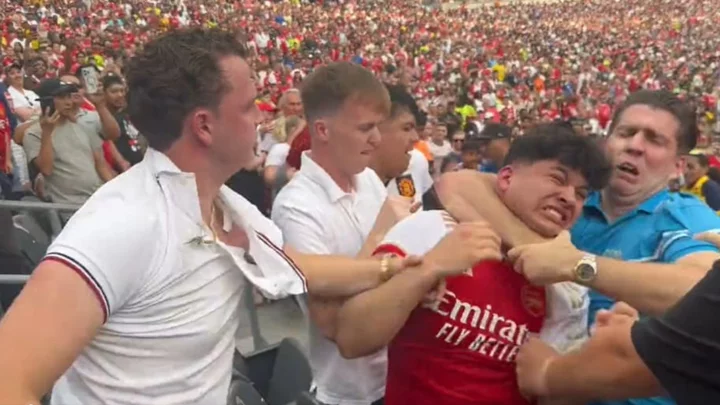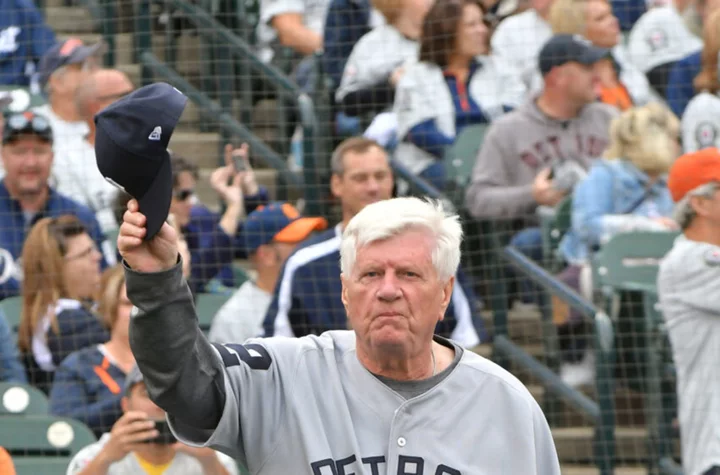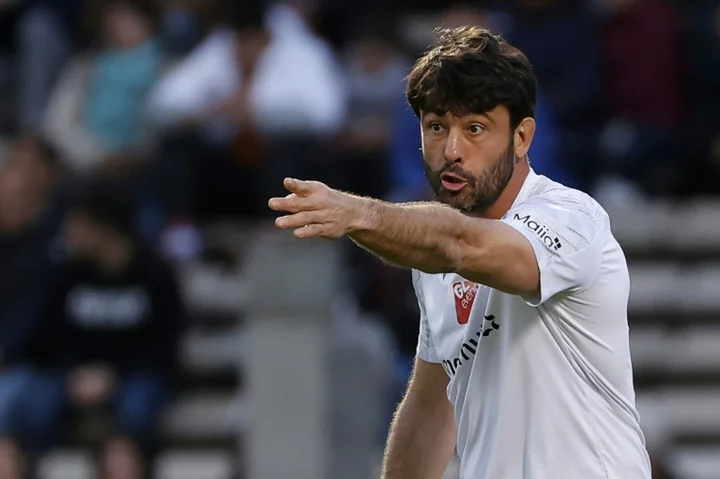USA’s narrow escape spells the end of Women’s World Cup dominance
Views: 2915
2023-08-01 18:56
The USA are still clinging on to their defence of the World Cup, but only just. Portugal’s Ana Capeta, brought on in stoppage time, came within the width of a post from sending the two-time defending champions crashing out of the tournament. If that’s how close the USA came to a first World Cup defeat since 2015, it’s a clear indication of how fragile their dominance appears to be. After only scraping through Group E as runners-up and with Sweden, who thrashed the USA at the Olympics two years ago, likely to be next in the last-16, there is little confidence that this is the same side who entered the tournament as favourites. Had Captea’s shot caught the inside of the post then the World Cup would have staged its biggest shock yet, with the dethroning of the four-time winners. Yet, even though Capeta’s strike agonisingly rebounded out, the nerves at the end as the USA survived only confirmed what many thought ahead of the World Cup. After draws against the Netherlands and Portugal, the first time the USA have ever failed to win two games in the World Cup group stage, it is clear that the gap between the defending champions and the rest of the world has closed. The rise of the European club game, with the increased professionalism of its leagues and the development of the Champions League, has fueled that growth. It is in Europe where tactical innovation and improvements in coaching have given teams a different way to play against the USA, reducing the advantage that their superior pool of talent and resources had previously given them. Portugal, denied a place in the knockout stages by the narrowest of margins, were a demonstration of that. Even in their first ever appearance at a Women’s World Cup and a domestic league that is significantly smaller than those in England, Germany or France, their development under Francisco Neto has mirrored the changes in women’s football since the last World Cup four years ago. Portugal are tactically versatile and have been boosted by a new wave of talent who are given the platform to shine. The 20-year-old Benfica forward Francisca Nazareth provided support to Jessica Silva, who is no longer the lone star in the team. The USA were disrupted by Portugal’s approach, as well as their defensive shape and a sophisticated press. Portugal controlled the central areas as Nazareth dropped in to form a midfield diamond and their technical ability allowed spells of possession where the European side took charge of the ball and played through the USA’s more rigid shape. It was the same against the Netherlands, where the USA trailed at half time. Lindsay Horan’s second-half equaliser only grew in significance as Portugal took the USA to the depths of a Group E decider. And yes, the USA have not been been at full strength in New Zealand, losing captain Becky Sauerbrunn and star forwards Mallory Swanson and Catarina Macario to injury before the tournament. They were a side who always looked caught between generations, the imbalance between selecting the 34-year-old Alex Morgan and the 37-year-old Megan Rapinoe, the veterans of the two-time defending champions, and the 14 players who were making their first appearances at the World Cup. It could just be the classic case of a team who have stuck together for a tournament too long and it did not take long for questions to be asked of the USA side after the Portugal draw. Carli Lloyd, a champion with the USA at both the 2015 and 2019 World Cups, hit out at the lack of motivation and hunger of her former team-mates, accusing those who remained of tacking playing at the World Cup for “granted”. Certainly, there is negativity off the field while on it, Vlatko Andonovski’s team are desperately lacking in inspiration or ideas. It leaves the USA vulnerable ahead of the knockout stages, and a contrast to the ambition of sides like Portugal. Sweden, who dismantled the USA 3-0 in the group stages of the Olympics, bring the same tactical freshness with the added edge of major tournament experience. Sweden will have nothing to fear and after surviving Portugal, the next surprise in the knockout stages would be if the USA are able to perform another escape and reach the quarter-finals. Read More Women’s World Cup TV schedule: How to watch every match today Women’s football world rankings: Who could take No 1 at the World Cup? Women’s World Cup golden boot: Who’s leading the top-scorer standings?

The USA are still clinging on to their defence of the World Cup, but only just. Portugal’s Ana Capeta, brought on in stoppage time, came within the width of a post from sending the two-time defending champions crashing out of the tournament. If that’s how close the USA came to a first World Cup defeat since 2015, it’s a clear indication of how fragile their dominance appears to be. After only scraping through Group E as runners-up and with Sweden, who thrashed the USA at the Olympics two years ago, likely to be next in the last-16, there is little confidence that this is the same side who entered the tournament as favourites.
Had Captea’s shot caught the inside of the post then the World Cup would have staged its biggest shock yet, with the dethroning of the four-time winners. Yet, even though Capeta’s strike agonisingly rebounded out, the nerves at the end as the USA survived only confirmed what many thought ahead of the World Cup. After draws against the Netherlands and Portugal, the first time the USA have ever failed to win two games in the World Cup group stage, it is clear that the gap between the defending champions and the rest of the world has closed.
The rise of the European club game, with the increased professionalism of its leagues and the development of the Champions League, has fueled that growth. It is in Europe where tactical innovation and improvements in coaching have given teams a different way to play against the USA, reducing the advantage that their superior pool of talent and resources had previously given them.
Portugal, denied a place in the knockout stages by the narrowest of margins, were a demonstration of that. Even in their first ever appearance at a Women’s World Cup and a domestic league that is significantly smaller than those in England, Germany or France, their development under Francisco Neto has mirrored the changes in women’s football since the last World Cup four years ago. Portugal are tactically versatile and have been boosted by a new wave of talent who are given the platform to shine. The 20-year-old Benfica forward Francisca Nazareth provided support to Jessica Silva, who is no longer the lone star in the team.
The USA were disrupted by Portugal’s approach, as well as their defensive shape and a sophisticated press. Portugal controlled the central areas as Nazareth dropped in to form a midfield diamond and their technical ability allowed spells of possession where the European side took charge of the ball and played through the USA’s more rigid shape. It was the same against the Netherlands, where the USA trailed at half time. Lindsay Horan’s second-half equaliser only grew in significance as Portugal took the USA to the depths of a Group E decider.
And yes, the USA have not been been at full strength in New Zealand, losing captain Becky Sauerbrunn and star forwards Mallory Swanson and Catarina Macario to injury before the tournament. They were a side who always looked caught between generations, the imbalance between selecting the 34-year-old Alex Morgan and the 37-year-old Megan Rapinoe, the veterans of the two-time defending champions, and the 14 players who were making their first appearances at the World Cup.
It could just be the classic case of a team who have stuck together for a tournament too long and it did not take long for questions to be asked of the USA side after the Portugal draw. Carli Lloyd, a champion with the USA at both the 2015 and 2019 World Cups, hit out at the lack of motivation and hunger of her former team-mates, accusing those who remained of tacking playing at the World Cup for “granted”. Certainly, there is negativity off the field while on it, Vlatko Andonovski’s team are desperately lacking in inspiration or ideas.
It leaves the USA vulnerable ahead of the knockout stages, and a contrast to the ambition of sides like Portugal. Sweden, who dismantled the USA 3-0 in the group stages of the Olympics, bring the same tactical freshness with the added edge of major tournament experience. Sweden will have nothing to fear and after surviving Portugal, the next surprise in the knockout stages would be if the USA are able to perform another escape and reach the quarter-finals.
Read More
Women’s World Cup TV schedule: How to watch every match today
Women’s football world rankings: Who could take No 1 at the World Cup?
Women’s World Cup golden boot: Who’s leading the top-scorer standings?









